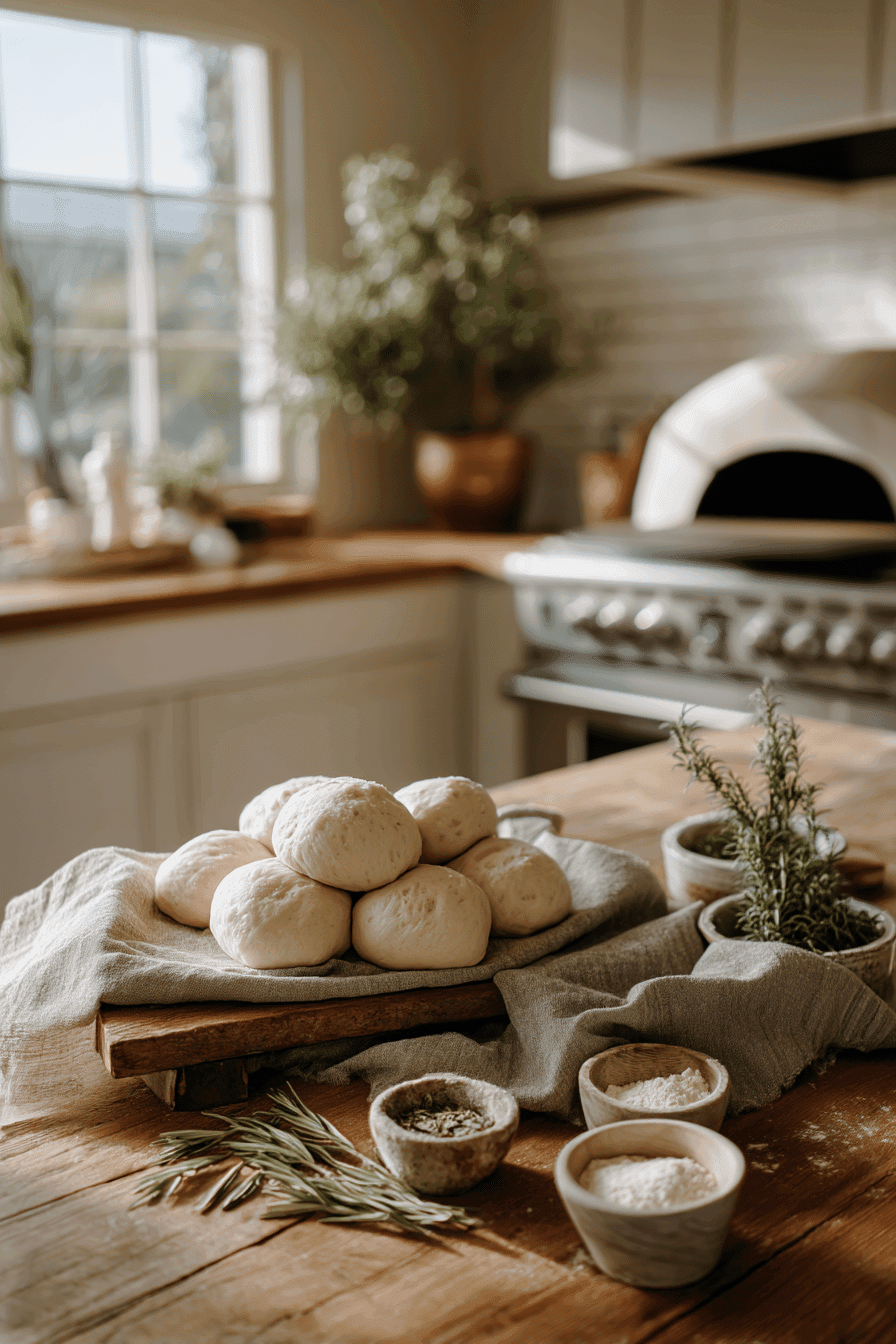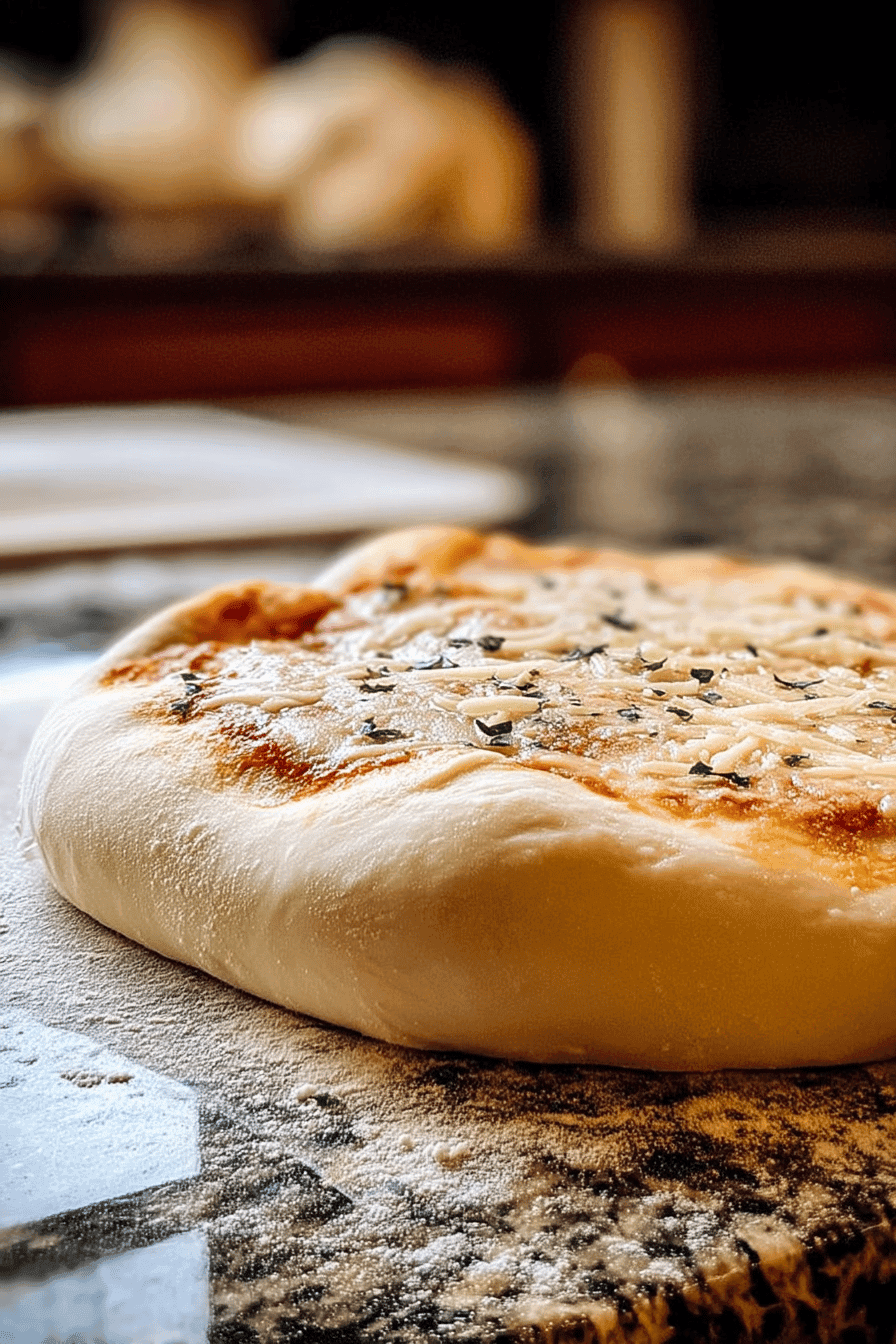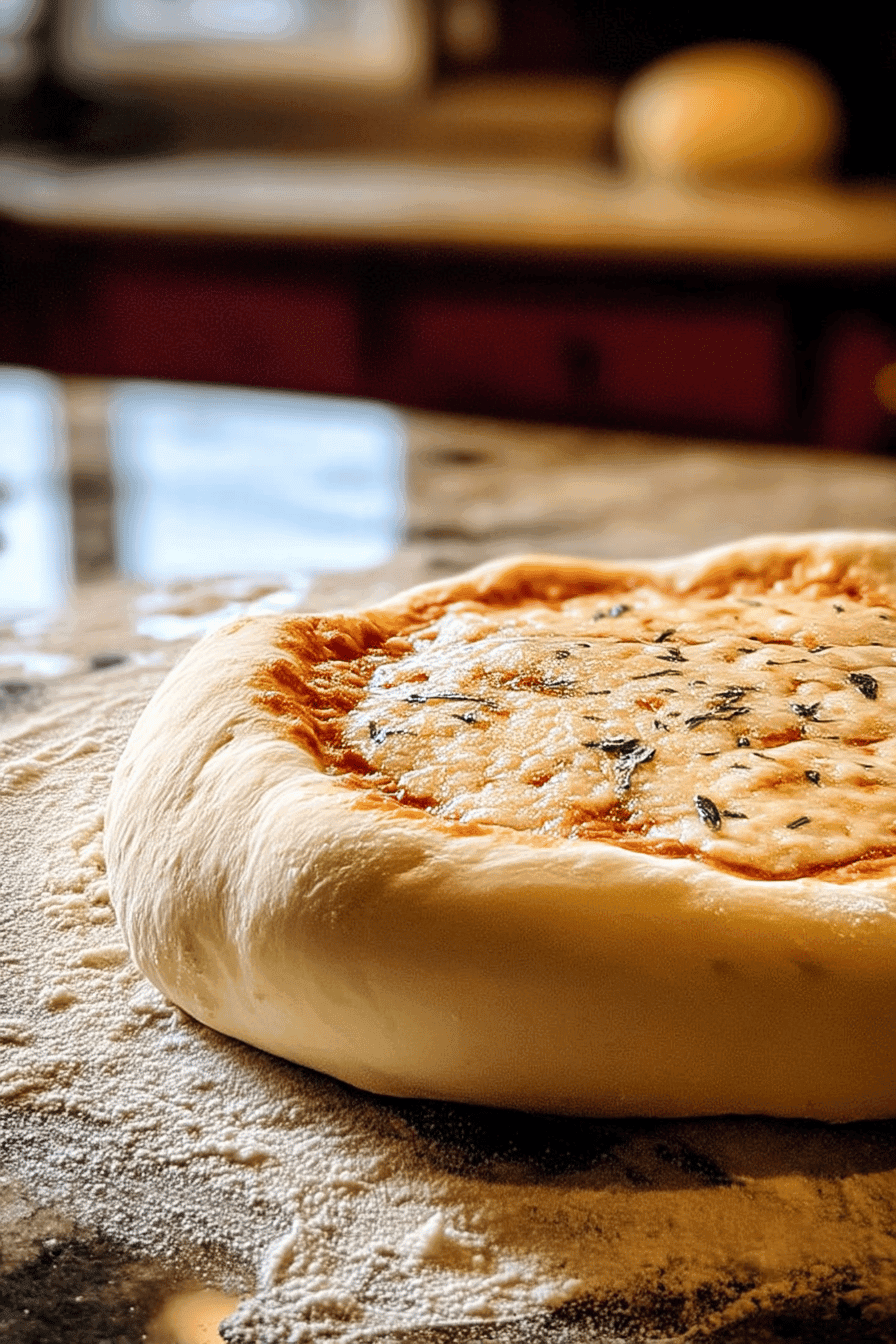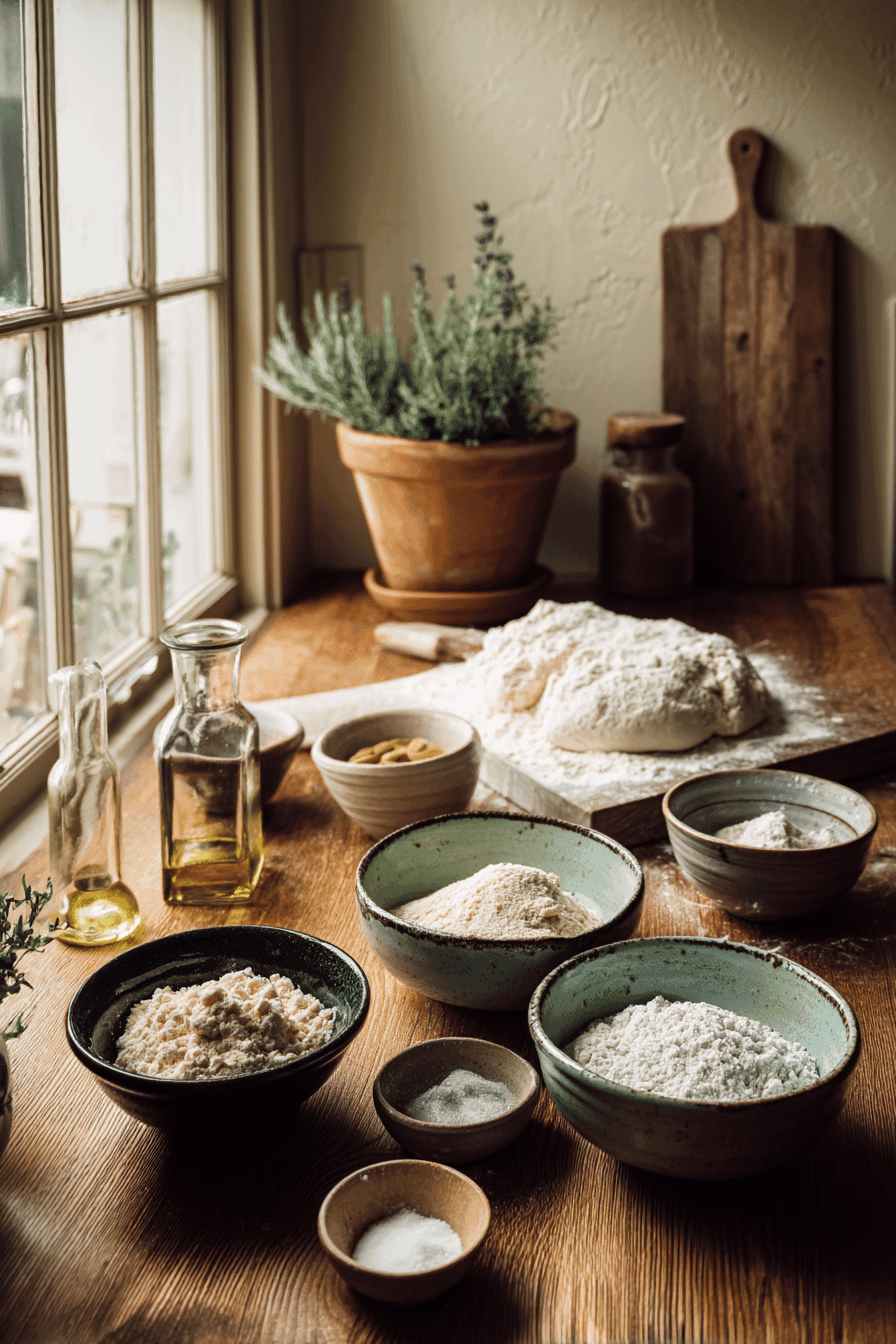Benefits and Advantages of Italian Pizza Dough Recipe
The Italian pizza dough recipe is prized for its simplicity and reliance on high-quality, basic ingredients, making it accessible to cooks of all levels. This straightforward recipe uses pantry staples that are easy to find, ensuring that anyone can recreate authentic Italian pizza at home. The dough’s natural fermentation enhances flavor and digestibility, allowing better nutrient absorption and developing a rich, complex taste. This recipe achieves the ideal balance of a tender, chewy interior with a crispy crust, reflecting traditional pizzeria standards. Beyond taste and texture, it adapts to various dietary preferences and occasions, making it versatile for different lifestyles while maintaining an authentic Italian experience.
Jump To
- 1. Benefits and Advantages of Italian Pizza Dough Recipe
- 2. Essential Ingredients for Italian Pizza Dough Recipe
- 3. Dietary Substitutions to Customize Your Italian Pizza Dough Recipe
- 4. How to Prepare the Perfect Italian Pizza Dough Recipe: Step-by-Step Guide
- 5. Advanced Tips and Variations
- 6. How to Store Italian Pizza Dough Recipe: Best Practices
- 7. Nutritional Value of Italian Pizza Dough Recipe
- 8. FAQs: Frequently Asked Questions About Italian Pizza Dough Recipe
- 9. Authentic Italian Neapolitan Pizza Dough Recipe for Perfect Homemade Pizza
Essential Ingredients for Italian Pizza Dough Recipe
- 5 cups (about 600 grams) all-purpose flour or 00 flour, plus extra for dusting
- 1.5 teaspoons instant dry yeast (or active dry yeast)
- 1.5 teaspoons sea salt (or up to 1 tablespoon kosher salt depending on taste)
- 2.25 cups (approximately 530 ml) cold water (or filtered water at room temperature, about 75-80°F for active dry yeast)
- 1 tablespoon extra virgin olive oil, plus more for drizzling
Optional toppings for reference include caramelized onions, arrabiata sauce, heirloom tomatoes, smoked mozzarella cheese, sautéed mushrooms, ricotta meatballs, and roasted peppers. Each core ingredient plays a crucial role: flour builds the dough’s structure, yeast initiates rise and airiness, salt enhances flavor, water hydrates, and olive oil adds softness and richness.
Dietary Substitutions to Customize Your Italian Pizza Dough Recipe
When tailoring the Italian pizza dough recipe to your dietary needs, several substitutions provide flexibility without sacrificing the dough’s character. Gluten-free diets can replace the traditional flour with certified gluten-free blends containing rice, tapioca, or almond flour, possibly adding binding agents such as xanthan gum for structure. Vegan adaptations are naturally compatible, but honey (if used) should be replaced with agave syrup or omitted. For individuals managing sodium intake, salt can be reduced or omitted, and salt-free yeast options sought when available.
Low-carb variations may incorporate almond or coconut flour with added binders to maintain dough elasticity, though textures may differ slightly. Through these thoughtful adjustments, the recipe remains accessible, enabling everyone to enjoy a traditional Italian pizza crust customized to personal health and preferences.
How to Prepare the Perfect Italian Pizza Dough Recipe: Step-by-Step Guide
- Activate yeast: In a large bowl, dissolve 1.5 teaspoons of instant dry yeast or active dry yeast in warm filtered water (about 75-80°F for active yeast). Let it sit 5-10 minutes until frothy. For vegan or dairy-free versions, use filtered water without additives.
- Mix dry ingredients: In a separate large bowl, combine 5 cups (600g) of flour and 1.5 teaspoons sea salt. Stir to distribute salt evenly but keep it separate from the yeast initially to avoid yeast inhibition.
- Combine wet and dry ingredients: Make a well in the flour and slowly pour in the activated yeast mixture along with 1 tablespoon of extra virgin olive oil. Stir gently to bring the dough together.
- Knead the dough: Turn the dough onto a floured surface and knead for 8 to 12 minutes by hand or use a dough hook on low speed until smooth, elastic, and slightly sticky. Adjust flour or water sparingly to achieve a soft yet resilient dough. The dough should bounce back when pressed, ensuring proper gluten development.
- Let the dough rise: Place the dough in a lightly oiled bowl, cover tightly with plastic wrap or a damp cloth, and proof in a warm, draft-free area for about 2 hours until doubled in size. Alternatively, refrigerate the dough for 24 to 72 hours (“retarding”) to deepen flavor and improve texture through slow fermentation.
- Divide and shape: Remove dough from the bowl and divide it into 6 equal portions. Shape each into a smooth ball and place on a lightly oiled tray. Cover to prevent drying.
- Stretch the dough: Flour the countertop, gently flatten each dough ball to ½ inch thickness, then stretch into a 10-inch round or oval by hand or with knuckles, avoiding tears.
- Prepare for baking: Dust a pizza peel or flat cardboard with semolina flour or cornmeal to prevent sticking. Transfer the stretched dough onto it, then add 2-3 tablespoons of sauce, toppings, and cheese, leaving a 1-inch crust edge.
- Bake: Preheat the oven with a pizza stone inside to 500-525°F and bake for 5 to 7 minutes or until the crust is golden and slightly charred. For lower-temperature ovens, finish under the broiler briefly for crisp edges.
- Finish and serve: Remove from oven, sprinkle with fresh basil and grated Parmesan if desired, and allow the pizza to rest a few minutes before slicing and serving.
By following these steps, you achieve an authentic Italian-style pizza with a delicate, chewy crust and a crisp bottom that mirrors the quality of wood-fired pizzerias.
For related recipes and tips, explore Crock Pot Pizza Casserole for a comforting variation and learn more about perfect chicken dishes from Chicken Mozzarella Pasta.
For further reading on traditional dough making, see this detailed guide on How to Make Authentic Italian Pizza Dough.
Need tips on baking with a pizza stone? Check out this expert article on Tips for Using a Pizza Stone.

Advanced Tips and Variations
To perfect your italian pizza dough recipe, consider fermenting the dough for up to 24-72 hours in the refrigerator. This slow cold fermentation improves flavor depth and dough elasticity, giving a more authentic Neapolitan crust. Using finely milled “00” flour can yield a delicate crumb and tender texture traditional to Italian pizza. For added complexity, try incorporating herbs such as rosemary or garlic powder into the dough to impart subtle aromatic notes.
Experimenting with whole wheat flour by substituting up to 50% of the all-purpose flour increases fiber content and adds a pleasant nutty flavor. Adjust hydration accordingly, as whole wheat flour absorbs more water. For thinner crusts, stretch the dough more extensively, while allowing longer rest periods before shaping encourages chewiness and strength in thicker crusts.
Investing in a pizza stone or steel for your oven replicates the heat retention of wood-burning ovens, producing a crisper bottom crust and ideal browning. Preheat the stone for at least 45 minutes at the highest oven temperature to maximize heat transfer. These approaches improve texture and flavor and offer options tailored to personal preferences and dietary goals.
How to Store Italian Pizza Dough Recipe: Best Practices
Proper storage of your italian pizza dough prolongs freshness and quality. After the initial rise, wrap dough balls tightly in plastic wrap or place them in an airtight container and refrigerate for up to 3 days. This refrigerated fermentation enhances flavor through slow yeast activity.
For longer storage, freeze dough before the rise stage by wrapping tightly in plastic and aluminum foil or using freezer-safe bags to prevent freezer burn. When ready to bake, thaw dough overnight in the refrigerator, then bring it to room temperature for about 30 minutes before shaping. This ensures the dough’s elasticity and ease of stretching.
Reheating cooked pizza is best done in a preheated oven rather than a microwave to maintain the desirable crispness of the crust. Using these storage and reheating methods helps preserve the dough’s texture, flavor, and overall quality.
Nutritional Value of Italian Pizza Dough Recipe
| Nutrient | Approximate Amount per Serving (1 Pizza) |
|---|---|
| Calories | 410 kcal |
| Carbohydrates | 81 g |
| Protein | 12 g |
| Total Fat | 4 g |
| Saturated Fat | 1 g |
| Monounsaturated Fat | 2 g |
| Polyunsaturated Fat | 1 g |
| Sodium | 589–720 mg |
| Potassium | 140 mg |
| Fiber | 4 g |
| Sugar | 0.3 g |
| Calcium | 20 mg |
| Iron | 5 mg |
This recipe offers a balanced nutritional profile with carbohydrates dominating due to the flour base, alongside moderate protein content from the gluten structure. The inclusion of olive oil contributes heart-healthy fats, while fiber depends on the type of flour used. Sodium can vary based on added salt amount but can be reduced for sensitive diets. The pizza dough is low in sugar and provides essential minerals, making it suitable for various nutritional needs while retaining authentic flavor.

FAQs: Frequently Asked Questions About Italian Pizza Dough Recipe
How do I make authentic Italian pizza dough from scratch?
Answer guidance: Provide a simple overview of key ingredients (flour type, yeast, water, salt), mention common mixing and kneading methods (by hand, mixer, or food processor), and include basic resting/proofing times. Highlight that using unbleached all-purpose or 00 flour yields a traditional thin, chewy crust. Keeping the answer clear and beginner-friendly helps satisfy users new to the recipe.
Can I freeze or refrigerate Italian pizza dough, and how should I thaw it properly?
Answer guidance: Explain freezing dough balls before rising, proper storage methods (airtight wrap), and thawing steps—typically thaw in fridge overnight, then bring to room temperature for 2–3 hours to allow proofing. Mention refrigeration slows fermentation for flavor and how long dough keeps fresh (up to 3 days refrigerated, ~6 months frozen). This addresses common preservation concerns.
What is the ideal flour and yeast to use for pizza dough to get the best texture?
Answer guidance: Compare bread flour, all-purpose, and 00 flour, emphasizing protein content and impact on chewiness and crust texture. Clarify that instant yeast can replace active dry yeast with no quantity change. Including this info helps users select ingredients matching their desired pizza style.
How hot should I bake Italian pizza, and can I use a pizza stone or cast iron skillet?
Answer guidance: Suggest oven temperatures (e.g., 450°F for home ovens, or 400°C for wood-fired ovens) and mention that pizza stones and cast iron skillets both help create a crisp crust. Briefly describe baking steps: preheat stone/skillet, shape dough, add toppings, and bake until crust is golden. This covers beginner baking questions and equipment options.
What should I do if my pizza dough doesn’t rise properly?
Answer guidance: List common causes like incorrect water temperature (ideal 20-25°C/68-77°F), old or inactive yeast, salt added too early, or cold room conditions. Advise on checking yeast freshness and ambient temperature for proofing. This question addresses troubleshooting, which many users seek. These FAQs are ordered to guide users from basics to specific concerns, use natural keyword phrases reflecting real user queries, and allow adding statistics or links (e.g., to recipes, baking tips, ingredient guides) in the answers. Keep answers concise but informative, focusing on solving users’ problems and clarifying common doubts.

Authentic Italian Neapolitan Pizza Dough Recipe for Perfect Homemade Pizza
- Total Time: 2 hours 15 minutes to several days
- Yield: 6 pizzas 1x
- Diet: Vegetarian
Description
🍕 Create perfect homemade Neapolitan pizza dough with a tender yet crisp crust that captures authentic Italian flavors.
👩🍳 Ideal for pizza enthusiasts wanting a traditional, flavorful base for endless topping combinations.
Ingredients
5 cups all-purpose flour or 00 flour, plus extra for dusting
1.5 teaspoons instant dry yeast (or active dry yeast)
1.5 teaspoons sea salt (or up to 1 tablespoon kosher salt)
2.25 cups cold water (or room temperature for active dry yeast)
1 tablespoon extra virgin olive oil, plus more for drizzling
Instructions
1. Preheat your oven as high as possible (500-525°F) with a pizza stone inside for 45 minutes to 1 hour.
2. In a large bowl or mixer, combine flour, salt, and yeast. For active dry yeast, bloom in warm water with sugar first.
3. Gradually add cold water while mixing. Knead by hand or mixer with dough hook for 8 to 12 minutes until smooth and slightly sticky.
4. Stir in olive oil toward the end of kneading.
5. Divide dough into 6 equal portions. Shape into smooth rounds and place on lightly oiled tray.
6. Drizzle with olive oil and cover tightly. Let rise at room temperature for about 2 hours until doubled.
7. For deeper flavor, refrigerate dough for 24-72 hours before shaping.
8. To shape, dust counter with flour and gently press and stretch dough into 10-inch circles.
9. Transfer dough to a peel dusted with semolina or cornmeal. Add sauce and toppings, leaving a 1-inch border.
10. Slide pizza onto preheated stone and bake 5 to 7 minutes until golden and crisp with slight charring.
11. Remove, top with fresh basil and Parmesan, and allow to rest before serving.
Notes
🍞 Use 00 flour for an authentic texture or bread flour for chewier crust.
⚠️ Keep salt separate from yeast initially to prevent yeast inhibition.
❄️ Dough can be frozen after shaping but before rising; thaw and rise before baking.
- Prep Time: 10-20 minutes
- Rising/fermentation time: 2 hours to 24-72 hours
- Cook Time: 5-7 minutes
- Category: Main Course
- Method: Baking
- Cuisine: Italian
Nutrition
- Serving Size: 1 pizza
- Calories: 410
- Sugar: 0.3g
- Sodium: 650mg
- Fat: 4g
- Saturated Fat: 1g
- Unsaturated Fat: 3g
- Trans Fat: 0g
- Carbohydrates: 81g
- Fiber: 4g
- Protein: 12g
- Cholesterol: 0mg
Keywords: Authentic, Italian, Neapolitan, Pizza Dough


